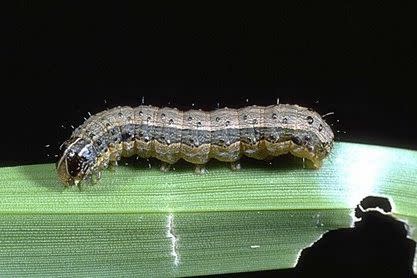Armyworms Are Marching In

People are always yapping about needing smaller lawns. Now that can happen, and they won't need to lift a finger. In fact, they can wake up in the morning to find their lawns completely gone, thanks to the infamous fall armyworm. Fall army worms are the larvae of a small brownish-gray moth. They plague a number of agricultural crops, such as corn, soybeans, cotton, peanuts, and sorghum, but when the pickings get slim due to hot, dry weather, the moths and caterpillars head for greener pastures, like your lawn that you've dutifully watered several times a week.
What do army worms look like? You'll never see them coming. Female moths will lay up to 2,000 tiny eggs right on the grass blades. The eggs hatch a few days later. At first, the tiny caterpillars are green with a black head, but as they devour the grass over a course of 14 days or so, they change to brown with white lines on the side and a reddish-brown head. They grow to more than an inch long. If you see this gobbling your grass, your lawn is in trouble.

Fall armyworms get their name because thousands of them literally march across a lawn like an army, eating as they go. People with heavily infested lawns report they can actually hear the munching. These caterpillars are sneaky assassins, moving only at night and crawling into silk-lined burrows in the day. You may first notice their presence as a brown patch of lawn that gets bigger every day. Or you may walk out one morning to find nothing but dirt where a lawn was just the night before.
Fall army worms infest just about every state east of the Mississippi, but are the most problematic in the Southeast. That's because where autumn comes early up north, they may be limited to one or two generations per year. In the South, you can get twice as many. Yay! Twice the chance of having a bare dirt yard! Let's turn on the sprinkler and play in the mud right now!
In the Crosshairs I have good news and bad news about army worm damage. If you have a Zoysia grass lawn, you're in the clear. Fall armyworms don't like Zoysia. The bad news is that they love Bermuda grass, St. Augustine, Kentucky bluegrass, and tall fescue. The first two usually survive the onslaught and come back. The latter two often die.
Defeat the Army! The key to defeating fall armyworms is spotting them early before they pull that last all-nighter on your lawn. For army worm treatment, if you catch them while the caterpillars are a half-inch long or smaller, you can take the natural route and spray your grass with a harmless bacterium called Bacillus thuringiensis (Bt) that kills only caterpillars. It won't work on mature caterpillars, though. For them, I recommend buying a bottle of garden insecticide labeled for armyworms that you can attach to the end of a hose. This makes spraying the lawn quick and easy. Granular lawn insecticides don't work well.

